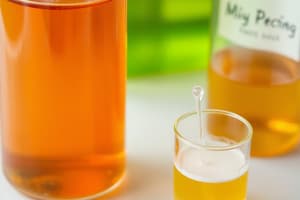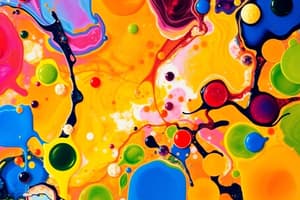Podcast
Questions and Answers
What is the primary purpose of crystallization?
What is the primary purpose of crystallization?
- To increase the temperature of a solution
- To evaporate the solvent from a solution
- To separate dissolved solids from a solution (correct)
- To mix two different solutions together
Which factor is NOT a consideration when choosing a separation technique?
Which factor is NOT a consideration when choosing a separation technique?
- Purity requirements
- Amount of mixture
- Physical properties of components
- Color of the components (correct)
In what context is crystallization commonly used?
In what context is crystallization commonly used?
- To combine multiple substances into one
- To purify solids from solutions (correct)
- To enhance the flavor of food products
- To create new chemical compounds
Which application of separation techniques would be most relevant to addressing environmental concerns?
Which application of separation techniques would be most relevant to addressing environmental concerns?
Which physical property is essential to determine when selecting a separation technique?
Which physical property is essential to determine when selecting a separation technique?
What principle does filtration utilize to separate components in a mixture?
What principle does filtration utilize to separate components in a mixture?
Which separation technique uses the process of heating to separate a solid from a liquid?
Which separation technique uses the process of heating to separate a solid from a liquid?
What is the main purpose of distillation in separation techniques?
What is the main purpose of distillation in separation techniques?
Which technique is specifically effective for separating components of a mixture with closely spaced boiling points?
Which technique is specifically effective for separating components of a mixture with closely spaced boiling points?
In which separation technique is the position of components influenced by their interaction with two different phases?
In which separation technique is the position of components influenced by their interaction with two different phases?
Centrifugation is primarily used to separate substances based on what property?
Centrifugation is primarily used to separate substances based on what property?
Which separation method would most likely be used to separate iron filings from sand?
Which separation method would most likely be used to separate iron filings from sand?
What property does decantation rely on to separate mixtures?
What property does decantation rely on to separate mixtures?
Flashcards
Filtration
Filtration
A technique that separates solids from liquids using a porous material, allowing the liquid (filtrate) to pass through, while the solid (residue) remains behind.
Decantation
Decantation
A technique that separates a liquid from a solid, by carefully pouring off the liquid, leaving the solid behind.
Evaporation
Evaporation
A technique that separates a solid dissolved in a liquid by heating the mixture, causing the liquid to evaporate and leaving the solid behind.
Distillation
Distillation
Signup and view all the flashcards
Chromatography
Chromatography
Signup and view all the flashcards
Centrifugation
Centrifugation
Signup and view all the flashcards
Magnetism
Magnetism
Signup and view all the flashcards
Crystallization
Crystallization
Signup and view all the flashcards
Magnetic Separation
Magnetic Separation
Signup and view all the flashcards
Study Notes
Introduction to Separation Techniques
- Separation techniques are methods used to isolate components from a mixture.
- The choice of technique depends on the properties of the components and the desired level of purity.
- Various separation techniques exist, ranging from simple to complex procedures.
Types of Separation Techniques
- Filtration: Separates solids from liquids by using a porous medium (filter). Liquid (filtrate) passes through, while the solid (residue) remains.
- Used for separating sand from water, or coffee grounds from coffee.
- Based on differences in particle size.
- Decantation: Separates a liquid from a solid by pouring off the liquid, leaving the solid behind.
- Useful for separating layers of immiscible liquids, or separating settled solids from a liquid.
- Based on differences in density between the liquid and solid.
- Evaporation: Separates a solid dissolved in a liquid by heating the mixture. The liquid evaporates, leaving the solid behind.
- Used for obtaining salt from seawater, or sugar from a sugar syrup.
- Based on differences in boiling points between the liquid and the dissolved solid.
- Distillation: Separates liquids with different boiling points by heating the mixture and condensing the vapor.
- Different liquids have different boiling points and can be separated based on volatility.
- Fractional distillation is used to separate liquids with closely spaced boiling points.
- Used to purify water, or separate components of petroleum.
- Chromatography: Separates components of a mixture based on their different interactions with stationary and mobile phases.
- Mobile phase carries the mixture; stationary phase interacts differently with each component.
- Different types exist (e.g., paper, thin-layer, gas, column).
- Useful for separating complex mixtures.
- Centrifugation: Separates substances with different densities by spinning the mixture at high speed. The denser components move to the bottom.
- Can separate solids from liquids, or different liquids within a mixture (e.g., separating blood cells from plasma).
- Useful for handling viscous solutions or when filtration is inefficient.
- Magnetism: Separates magnetic materials from non-magnetic materials by using a magnet.
- Used to remove metal shavings from sand, or separate iron filings from other materials.
- Based on the magnetic properties of the substances.
- Crystallization: Separates dissolved solids from a solution by allowing the solution to cool slowly. The solute crystallizes out of the solution.
- Used to purify solids from solutions.
- Based on differences in solubility at different temperatures.
Factors Affecting Separation Techniques
- Physical properties of components: Boiling point, density, magnetism, solubility, and other relevant properties dictate the ideal separation technique.
- Amount of mixture: The scale of the mixture influences the practicality and cost of the chosen method.
- Purity requirements: The desired degree of purity guides the selection of the separation technique.
Applications of Separation Techniques
- Industrial applications: Purification of chemicals, separation of petroleum products, and production of food products.
- Environmental applications: Removing pollutants from water, and separating hazardous materials.
- Medical applications: Separating blood components, purifying drugs, and creating vaccines.
Studying That Suits You
Use AI to generate personalized quizzes and flashcards to suit your learning preferences.



